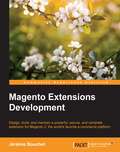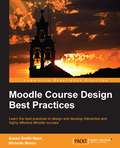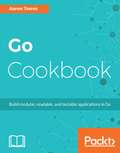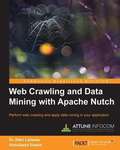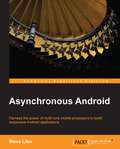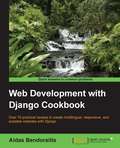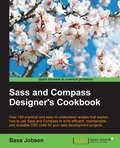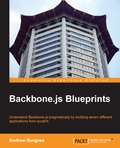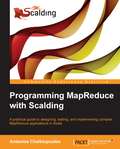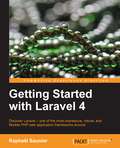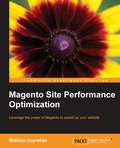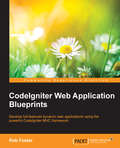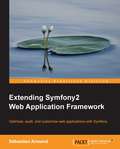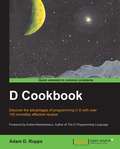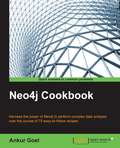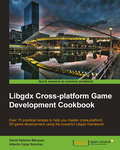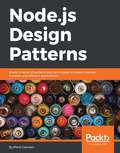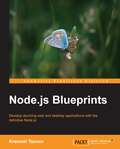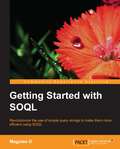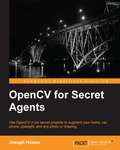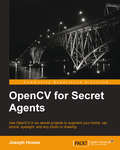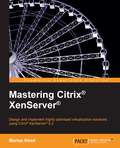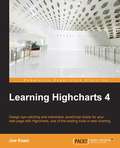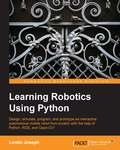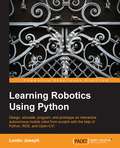- Table View
- List View
Magento Extensions Development
by Jérémie BouchetIf you want to write a specific customization or a large new and full-featured extension on Magento 2, this book is intended for you. You must be an intermediate to professional-level developer in PHP to appreciate this book.
Moodle Course Design Best Practices
by Susan Smith Nash Michelle MooreThis book is an easy-to-follow guide with a hands-on approach that will help you learn the best practices for designing attractive and highly interactive courses with the help of Moodle. This book can be used by training managers, teachers, instructors, Moodle network specialists, instructional designers, and e-learning entrepreneurs. If you are involved in online, cloud-based education, training, or professional development, this is the book for you. No prior experience with Moodle is required, though it would be helpful to understand the basics of using HTML and also working with different multimedia file formats and social media. If you would like to find a very easy and convenient way to organize learning activities along with group projects and activities, then this is the book for you.
Go Cookbook: Over 85 Recipes To Build Modular, Readable, And Testable Golang Applications Across Various Domains, 2nd Edition
by Aaron TorresBridge the gap between basic understanding of Go and use of its advanced features About This Book • Discover a number of recipes and approaches to develop modern back-end applications • Put to use the best practices to combine the recipes for sophisticated parallel tools • This book is based on Go 1.8, which is the latest version Who This Book Is For This book is for web developers, programmers, and enterprise developers. Basic knowledge of the Go language is assumed. Experience with back-end application development is not necessary, but may help understand the motivation behind some of the recipes. What You Will Learn • Test your application using advanced testing methodologies • Develop an awareness of application structures, interface design, and tooling • Create strategies for third-party packages, dependencies, and vendoring • Get to know tricks on treating data such as collections • Handle errors and cleanly pass them along to calling functions • Wrap dependencies in interfaces for ease of portability and testing • Explore reactive programming design patterns in Go In Detail Go (a.k.a. Golang) is a statically-typed programming language first developed at Google. It is derived from C with additional features such as garbage collection, type safety, dynamic-typing capabilities, additional built-in types, and a large standard library. This book takes off where basic tutorials on the language leave off. You can immediately put into practice some of the more advanced concepts and libraries offered by the language while avoiding some of the common mistakes for new Go developers. The book covers basic type and error handling. It explores applications that interact with users, such as websites, command-line tools, or via the file system. It demonstrates how to handle advanced topics such as parallelism, distributed systems, and performance tuning. Lastly, it finishes with reactive and serverless programming in Go. Style and approach This guide is a handy reference for developers to quickly look up Go development patterns. It is a companion to other resources and a reference that will be useful long after reading it through the first time. Each recipe includes working, simple, and tested code that can be used as a reference or foundation for your own applications.
Web Crawling and Data Mining with Apache Nutch
by Zakir Laliwala Abdulbasit ShaikhThis book is a user-friendly guide that covers all the necessary steps and examples related to web crawling and data mining using Apache Nutch."Web Crawling and Data Mining with Apache Nutch" is aimed at data analysts, application developers, web mining engineers, and data scientists. It is a good start for those who want to learn how web crawling and data mining is applied in the current business world. It would be an added benefit for those who have some knowledge of web crawling and data mining.
Asynchronous Android
by Steve LilesConcurrent Programming on Android is a step-by-step guide that builds a complete picture of the concurrency constructs available on the Android platform.This book is for Android developers who want to learn about the advanced concepts of Android programming. No prior knowledge of concurrency and asynchronous programming is required. This book is also targeted towards Java experts who are new to Android.
Web Development with Django Cookbook
by Aidas BendoraitisIf you have created websites with Django, but you want to sharpen your knowledge and learn some good approaches for how to treat different aspects of web development, you should definitely read this book. It is intended for intermediate and professional Django users who need to build projects which must be multilingual, functional on devices of different screen sizes, and which scale over time.
Sass and Compass Designer's Cookbook
by Bass JobsenOver 120 practical and easy-to-understand recipes that explain how to use Sass and Compass to write efficient, maintainable, and reusable CSS code for your web development projects About This Book * Leverage Sass to make your CSS code maintainable, reusable and prevent code duplications * Shorten debug time with Sass when creating complex CSS code for different browsers and devices * Write easy and bullet-proof CSS with Compass using this step-by-step and detailed guide Who This Book Is For This book is mainly intended for web developers and designers who are comfortable with CSS and HTML. If you are someone with some experience with CSS, you will find the learning curve of learning Sass syntax to be less steep. Basic knowledge of web development is helpful but you don't have to be a programmer to understand Sass. What You Will Learn * Spend less time debugging code * Compile Sass code into readable and maintainable CSS * Integrate Sass in your own projects * Reuse your code to prevent code duplications * Write reusable and portable CSS code * Make use of pre-built and established code written by other developers * Reduce development and maintenance time of your projects * Set up a development environment with Gulp In Detail Sass and Compass Designer's Cookbook helps you to get most out of CSS3 and harness its benefits to create engaging and receptive applications. This book will help you develop faster and reduce the maintenance time for your web development projects by using Sass and Compass. You will learn how to use with CSS frameworks such as Bootstrap and Foundation and understand how to use other libraries of pre-built mixins. You will also learn setting up a development environment with Gulp. This book guides you through all the concepts and gives you practical examples for full understanding. Style and approach This book is the perfect mix of essential theory combined with real-life examples and problems, with clear explanations of the more sophisticated Sass concepts. Learn Sass and Compass with practical and well-explained example code. This book follows a problem and solution approach that is convenient to understand and follow.
Backbone.js Blueprints
by Andrew BurgessThis book is an easy-to-follow guide which is full of examples that will take you through building seven very different web applications with Backbone. The code is broken down into manageable bites and then thoroughly explained. If you are ready to learn about building frontend applications in Backbone, this is the book for you. Perhaps you've dipped your toe into Backbone and are ready to take the plunge. Even if you haven't, this book will teach you everything you need to know to build solid frontend apps with Backbone. You'll need to be pretty good at JavaScript and have a working knowledge of HTML and CSS, but other than that, you're good to go!
Programming MapReduce with Scalding
by Antonios ChalkiopoulosThis book is an easy-to-understand, practical guide to designing, testing, and implementing complex MapReduce applications in Scala using the Scalding framework. It is packed with examples featuring log-processing, ad-targeting, and machine learning. This book is for developers who are willing to discover how to effectively develop MapReduce applications. Prior knowledge of Hadoop or Scala is not required; however, investing some time on those topics would certainly be beneficial.
Getting Started with Laravel 4
by Raphaël SaunierThis book follows a practical and easy-to-follow approach and is packed with real-world examples to understand all the fundamentals and concepts in a very concise way. This book is ideal for web developers who want to get up to speed with Laravel quickly. You are expected to have some experience with the PHP programming language - or any C-like languages such as JavaScript, Perl, or Java - along with some understanding of basic OOP concepts. Any experience with MVC frameworks such as ASP.NET MVC or Ruby on Rails will certainly be beneficial but not required. Lastly, some familiarity with command line interfaces will also help but is not essential either.
Magento Site Performance Optimization
by Mathieu NayrollesMagento Site Performance Optimization follows a handson, easytofollow approach, which focuses on the optimization of Magento's performance. Each chapter has a very logical flow, which makes the book readerfriendly. This book is written for Magento administrators who wish to optimize their store to increase performance, without spending thousands of dollars a year for the enterprise edition of Magento. It is noteworthy that Magento, as a project, comes with a gigantic code base and tools; however, the reader needs to be up for the challenge, ready to produce their own code to make the most of its code base.
CodeIgniter Web Application Blueprints
by Rob FosterIf you are a PHP programmer or developer looking for a framework to quickly develop your applications, this book is for you. The prerequisites needed would be prior experience with CodeIgniter.
Extending Symfony2 Web Application Framework
by Sébastien ArmandWith lots of practical, hands-on, step-by-step examples, this book will lead you through how to extend and optimize your Symfony2 framework. If you have a good understanding of how Symfony works and are now trying to integrate complex tasks in your application, or want to better organize your application by keeping each piece of code where it belongs so it can be decoupled and easily used elsewhere, then this book is for you.
D Cookbook
by Adam D. RuppeIn Detail D is a modern programming language that uses the familiar C family syntax while offering advanced modeling capabilities, safety guarantees, programmer productivity, and high efficiency. It helps you to get the most out of your hardware and your programmers simultaneously, saving both development and deployment costs. This practical guide will walk you through getting the work done with D, from writing your first program to writing advanced autogenerated objects, with notes based on real-world experiences telling you about potential pitfalls and how to avoid them. You'll use some of the third-party libraries available for D to get code working fast, including access to database engines, image processing, and more. Approach A recipe-packed reference guide filled with practical tasks that are concisely explained to develop and broaden the user's abilities with the D programming language. Who this book is for If you are an experienced programmer who is looking to explore a language that offers plenty of advantages over more established programming languages, this is the book for you. We assume that you are already familiar with general programming language basics, but you do not need to be a proficient user of D.
Neo4j Cookbook
by Ankur GoelIf you are already using Neo4j in your application and want to learn more about data analysis or database graphs, this is the book for you. This book also caters for your needs if you are looking to migrate your existing application to Neo4j in the future. We assume that you are already familiar with any general purpose programming language and have some familiarity with Neo4j.
Libgdx Cross-platform Game Development Cookbook
by Alberto Cejas Sanchez David Saltares MarquezIf you want to make cross-platform games without the hassle and dangers of writing platform-specific code, or If you are a game programmer who may have some experience with Java and you want to learn everything you need to know about Libgdx to produce awesome work, this is the book for you. To take full advantage of the recipes in this book, you are expected to be familiar with java with good game programming knowledge.
Node.js Design Patterns
by Mario CasciaroIf you're a JavaScript developer interested in a deeper understanding of how to create and design Node.js applications, this is the book for you.
Node.js Blueprints
by Krasimir TsonevA straightforward, practical guide containing step-by-step tutorials that will push your Node.js programming skills to the next level. If you are a web developer with experience in writing client-side JavaScript and want to discover the fascinating world of Node.js to develop fast and efficient web and desktop applications, then this book is for you.
Getting Started with SOQL
by Magulan DThis is a practical tutorial-based guide on using the new SOQL language, aimed at Force.com developers. Each topic is discussed with the help of standard SOQL queries. If you are a Salesforce.com developer or administrator, this book will help you to avoid hitting limits set by Salesforce.com. For those of you who are preparing for advanced developer Salesforce.com certification, this book will also be particularly useful.
OpenCV for Secret Agents
by Joseph Howse<P><P>Use OpenCV in six secret projects to augment your home, car, phone, eyesight, and any photo or drawing <P><P>About This Book <P><P>Build OpenCV apps for the desktop, the Raspberry Pi, Android, and the Unity game engine <P><P>Learn real-time techniques that can be used to classify images, detecting and recognizing any person or animal, and studying motion and distance with superhuman precision <P><P>Design hands-free interfaces that are practical in home automation, in cars, and in discrete surveillance <P><P>Who This Book Is For <P><P>This book is for programmers who want to expand their skills by building fun, smart, and useful systems with OpenCV. The projects are ideal in helping you to think creatively about the uses of computer vision, natural user interfaces, and ubiquitous computers (in your home, car, and hand). <P><P>What You Will Learn <P><P>Install OpenCV, a Python development environment, and an Android development environment on Windows, Mac, or Linux and install a Unity development environment on Windows or Mac <P><P>Get to grips with motion detection and gesture recognition as a means of controlling a guessing game on a smartphone <P><P>Detect car headlights, estimate distances to them, and provide feedback to the driver <P><P>Spot and recognize human faces and cat faces as a means of controlling an alarm <P><P>Amplify motion in real-time video so that a person's heartbeat and breathing become clearly visible <P><P>Draw a ball-in-a-maze puzzle on paper and see it come to life as a physics simulation on a smartphone <P><P>Integrate OpenCV with other libraries, as well as popular frameworks for GUI apps and games <P><P>In Detail <P><P>OpenCV is a grand collection of image processing functions and computer vision algorithms. It is open source, it supports many programming languages and platforms, and it is fast enough for many real-time applications. What a lot of gadgets we can build with such a handy library! <P><P>Taking inspiration from the world of James Bond, this book adds a spark of adventure and computer vision to your daily routine. Protect your home and car with intelligent camera systems that analyze people, cats, and obstacles. Let your search engine praise or criticize the images that it finds. Hear a voice from your phone that responds to your body language. Attune yourself to another person's rhythm by glancing at a display that magnifies a heartbeat or a breath. Learn OpenCV and see your world as never before.
OpenCV for Secret Agents
by Joseph HowseThis book is for programmers who want to expand their skills by building fun, smart, and useful systems with OpenCV. The projects are ideal in helping you to think creatively about the uses of computer vision, natural user interfaces, and ubiquitous computers (in your home, car, and hand).
Mastering Citrix® XenServer®
by Martez ReedIf you are an administrator who is looking to gain a greater understanding of how to design and implement a virtualization solution based on Citrix® XenServer®, then this book is for you. The book will serve as an excellent resource for those who are already familiar with other virtualization platforms, such as Microsoft Hyper-V or VMware vSphere. The book assumes that you have a good working knowledge of servers, networking, and storage technologies.
Learning Highcharts
by Joe KuanA complete practical and comprehensive tutorial with clear and step-by-step instructions along with many examples. It's packed with examples, code samples and practical tips in a no-nonsense way. This book is both for beginners and advanced web developers who need to create interactive charts for their web applications. It primarily targets JavaScript Web developers who want to use the Highcharts library to prepare interactive and professional-quality charts and graphs for their applications quickly and easily. Prior experience with JavaScript is assumed.
Learning Robotics Using Python
by Lentin Joseph<P><P>Design, simulate, program, and prototype an interactive autonomous mobile robot from scratch with the help of Python, ROS, and Open-CV! <P><P>About This Book <P><P>Design, simulate, build and program an interactive autonomous mobile robot <P><P>Program Robot Operating System using Python <P><P>Get a grip on the hands-on guide to robotics for learning various robotics concepts and build an advanced robot from scratch <P><P>Who This Book Is For <P><P>If you are an engineer, a researcher, or a hobbyist, and you are interested in robotics and want to build your own robot, this book is for you. Readers are assumed to be new to robotics but should have experience with Python. <P><P>What You Will Learn <P><P>Understand the core concepts and terminologies of robotics <P><P>Create 2D and 3D drawings of robots using freeware such as LibreCAD and Blender <P><P>Simulate your robot using ROS and Gazebo <P><P>Build robot hardware from the requirements <P><P>Explore a diverse range of actuators and its interfacing <P><P>Interface various robotic sensors to robots <P><P>Set up and program OpenCV, OpenNI, and PCL to process 2D/3D visual data <P><P>Learn speech processing and synthesis using Python <P><P>Apply artificial intelligence to robots using Python <P><P>Build a robot control GUI using Qt and Python <P><P>Calibration and testing of robot <P><P>In Detail <P><P>Learning about robotics will become an increasingly essential skill as it becomes a ubiquitous part of life. Even though robotics is a complex subject, several other tools along with Python can help you design a project to create an easy-to-use interface. <P><P>Learning Robotics Using Python is an essential guide for creating an autonomous mobile robot using popular robotic software frameworks such as ROS using Python. It also discusses various robot software frameworks and how to go about coding the robot using Python and its framework. It concludes with creating a GUI-based application to control the robot using buttons and slides. <P><P>By the end of this tutorial, you'll have a clear idea of how to integrate and assemble all things into a robot and how to bundle the software package.
Learning Robotics Using Python
by Lentin JosephIf you are an engineer, a researcher, or a hobbyist, and you are interested in robotics and want to build your own robot, this book is for you. Readers are assumed to be new to robotics but should have experience with Python.
